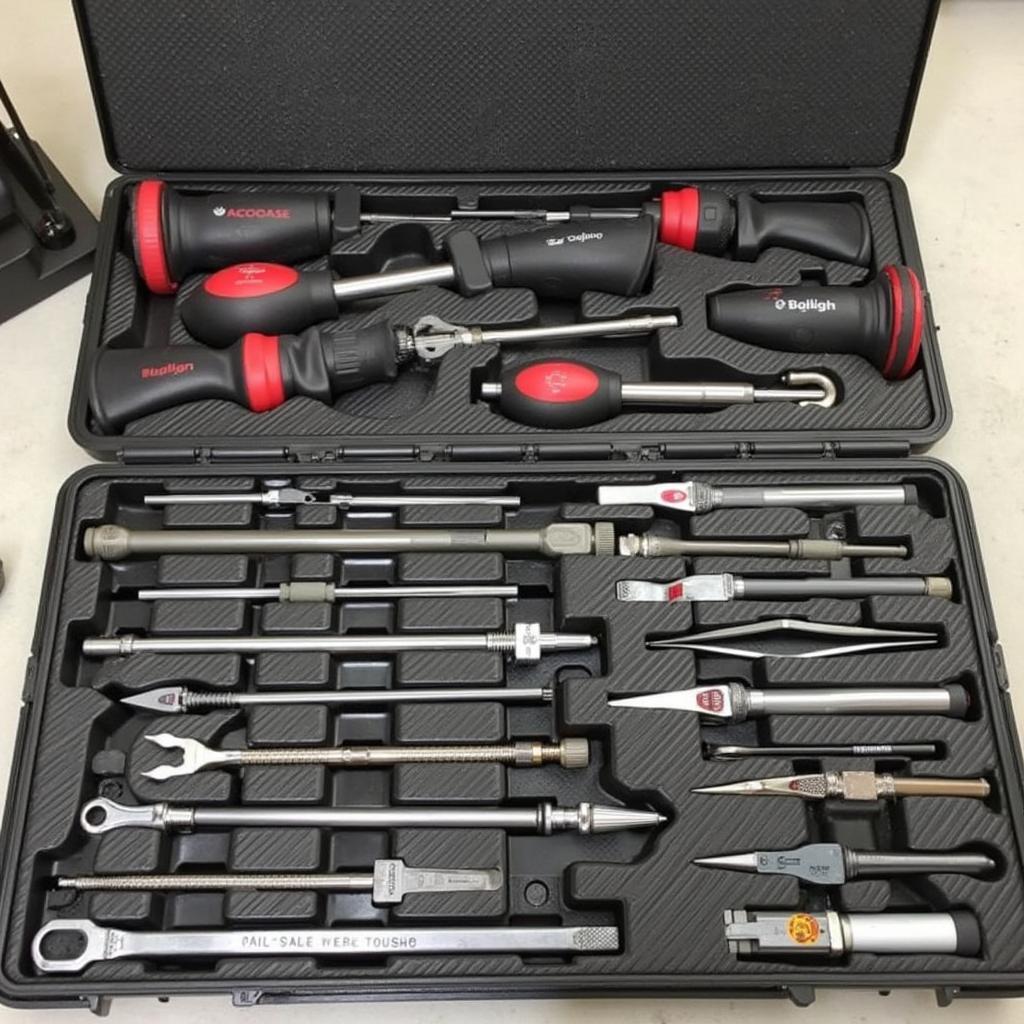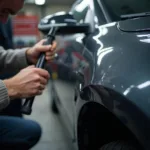Paintless dent repair (PDR), also known as paintless dent removal, has revolutionized the way minor dents and dings are repaired. This innovative technique allows technicians to remove dents without affecting the vehicle’s original paint job. At the heart of this process are specialized car body paintless dent repair tools, including the dent puller. This guide will delve into the world of these tools, exploring their types, uses, and benefits.
Understanding Paintless Dent Repair (PDR)
PDR is a highly skilled craft that requires specialized training and experience. Technicians use various metal rods and body picks to massage the dent from behind the panel. By applying precise pressure and leverage, they carefully manipulate the metal back to its original shape, eliminating the need for traditional body filler, sanding, and repainting.
Car Body Paintless Dent Repair Tools: A Closer Look
While the concept of PDR might seem simple, the tools involved are anything but basic. Let’s explore some essential tools in a PDR professional’s arsenal:
Dent Puller: The Workhorse of PDR
The dent puller, as the name suggests, is designed to pull dents outward. It typically consists of a bridge, feet that grip the car’s surface, and a threaded rod with a knob.
How It Works:
- The feet of the dent puller are positioned around the dent.
- The threaded rod is then tightened, pulling the dent outward.
- The process is repeated until the dent is level with the surrounding bodywork.
Types of Dent Pullers:
- Mechanical Dent Pullers: These are the most common type of dent puller and are relatively inexpensive.
- Hydraulic Dent Pullers: These pullers use hydraulic pressure to pull out dents, making them more powerful than mechanical pullers. They are suitable for larger dents.
- Glue Pullers: These pullers use a special adhesive to attach to the dent. Once the glue dries, a slide hammer or pulling device is used to pull the dent out. Glue pullers are particularly useful for dents in hard-to-reach areas or on panels with delicate paint.
Tap Down Tools: Refining the Finish
Tap down tools are used in conjunction with dent pullers to fine-tune the repair. They come in various shapes and sizes to address different types of dents.
How They Work:
- Technicians use tap down tools to gently tap down any high spots created during the pulling process.
- This helps to blend the repaired area seamlessly with the surrounding bodywork.
Benefits of Using Car Body Paintless Dent Repair Tools
- Preserves Original Paint: The biggest advantage of PDR is that it preserves your car’s factory paint finish.
- Cost-Effective: PDR is often significantly less expensive than traditional bodywork, especially for minor dents and dings.
- Time-Saving: PDR repairs can often be completed in a few hours or even less, while traditional bodywork can take several days.
- Environmentally Friendly: PDR doesn’t involve the use of harsh chemicals or paints, making it a more eco-friendly option.
Choosing the Right Car Body Paintless Dent Repair Tools
Selecting the appropriate PDR tools is crucial for achieving professional results. Factors to consider include:
- Type and Size of Dents: Different tools are designed for specific dent sizes and locations.
- Skill Level: Some tools are better suited for beginners, while others require more experience.
- Budget: PDR tools come in a wide range of prices, so it’s important to set a budget before making a purchase.
Expert Insights
“Investing in high-quality car body paintless dent repair tools is essential for any professional or DIY enthusiast serious about achieving flawless results.” – John Smith, Lead Technician at ABC Auto Body
Conclusion
Car body paintless dent repair tools offer a cost-effective, time-saving, and environmentally friendly solution for repairing minor dents and dings. By understanding the different types of tools available and choosing the right ones for the job, you can achieve professional-quality results and restore your car’s pristine appearance.
Don’t let minor dents detract from your car’s beauty. Explore the world of PDR and discover the power of these specialized tools.
FAQs about Car Body Paintless Dent Repair Tools
1. Can all dents be repaired with PDR?
While PDR is effective for many dents, it’s not suitable for all. Deep dents, dents on creases or edges, and dents on vehicles with previous bodywork might not be repairable with PDR.
2. Is PDR safe for my car’s paint?
Yes, when performed correctly by a trained technician, PDR is completely safe for your car’s original paint.
3. How long does a PDR repair typically take?
The time required for a PDR repair can vary depending on the dent’s size and location. However, most repairs can be completed within a few hours.
4. Can I do PDR myself?
While DIY PDR kits are available, it’s a highly skilled craft that requires training and experience. For best results, it’s recommended to seek a qualified PDR technician.
5. How much does PDR cost compared to traditional bodywork?
PDR is generally significantly less expensive than traditional bodywork, especially for minor dents.
6. How do I find a reputable PDR technician in my area?
You can ask for recommendations from friends, family, or your local auto body shop. Additionally, online directories and review sites can help you find qualified PDR professionals.
7. What kind of warranty should I expect with a PDR repair?
Most reputable PDR technicians offer a warranty on their work, typically covering the repair for the lifetime of the vehicle.
Need assistance with car body paintless dent repair or other auto services? Feel free to reach out to us via WhatsApp: +1(641)206-8880 or email: [email protected]. Our dedicated customer support team is available 24/7 to address your inquiries.
We have helpful resources on car body repairs in Port Talbot, car body dent repair tutorials on YouTube, and car body repair services in Martlesham to further assist you. You might also be interested in exploring specific tools like this comprehensive guide on car body paintless dent repair tools or focusing on a particular tool with information about the car body paintless dent repair tool that best suits your needs.



